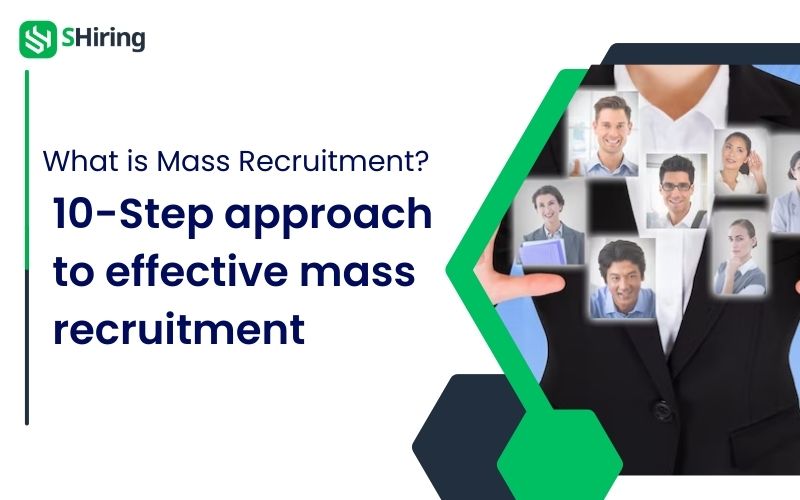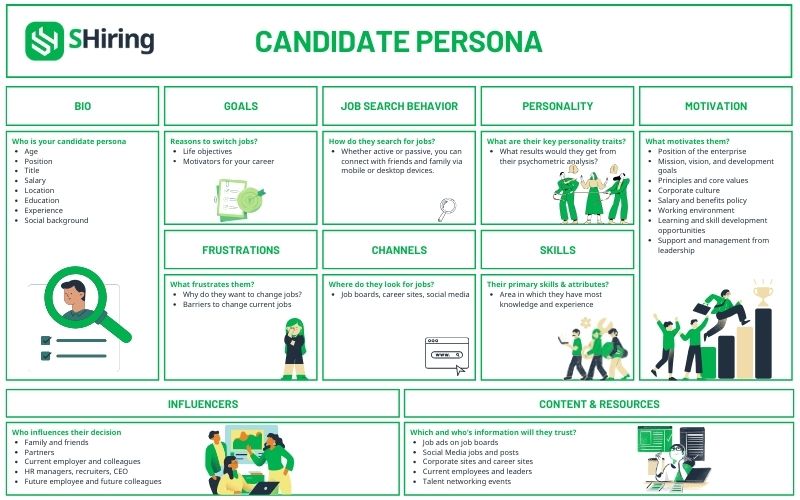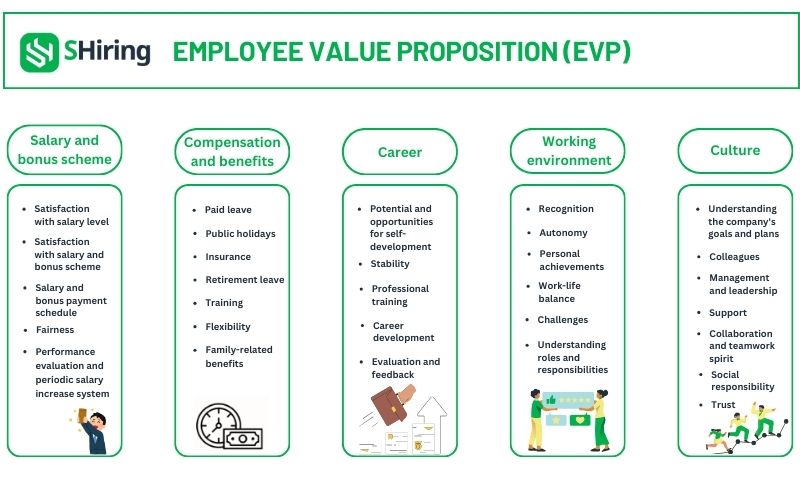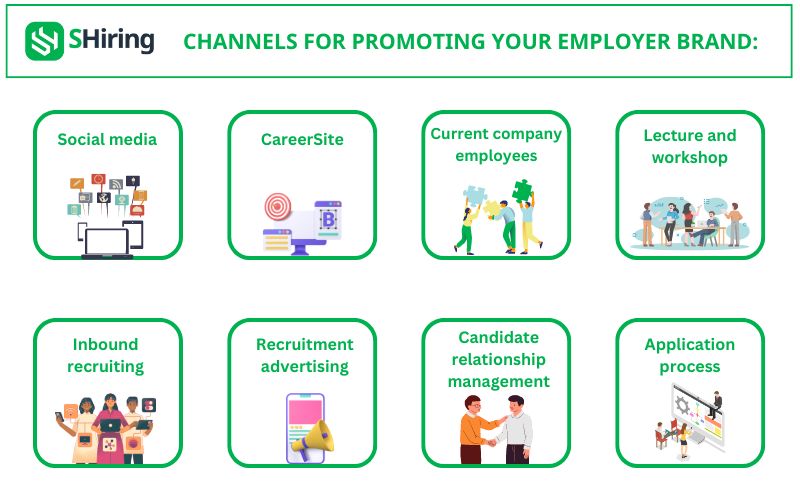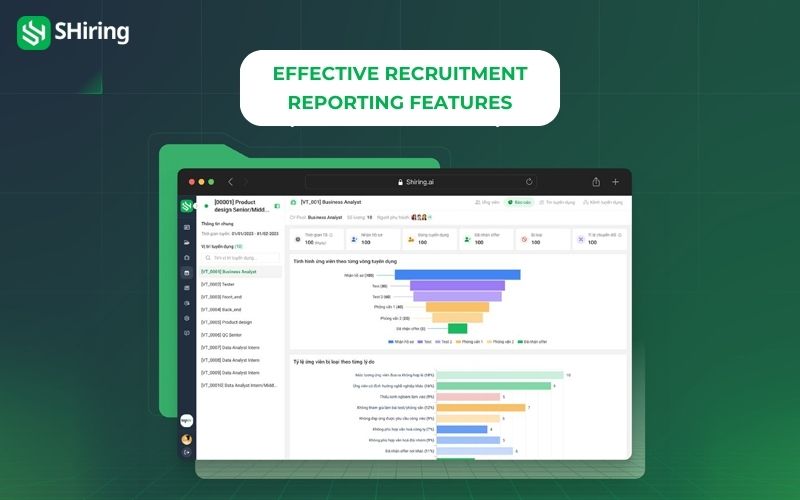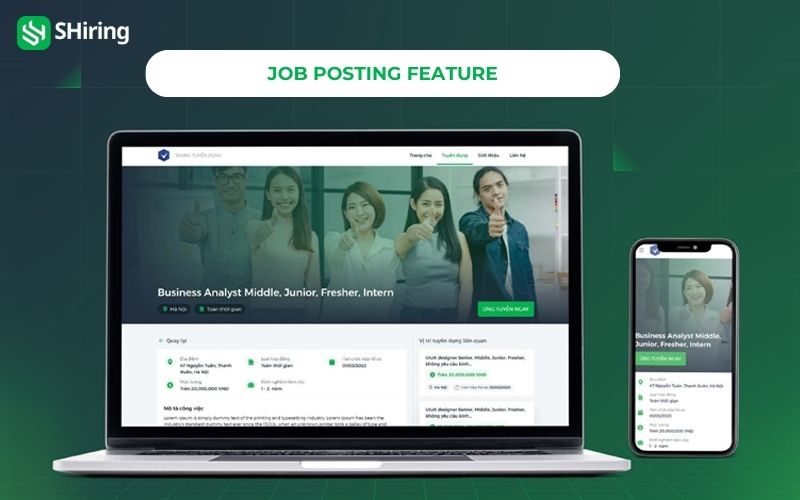Feeling overwhelmed by hiring a large number of employees quickly? This comprehensive guide explores mass recruitment strategies, highlighting its benefits and challenges. Discover how to create a winning recruitment plan, expand your candidate pool, and leverage technology for efficient screening and assessment. Learn how SHiring‘s features can streamline your mass recruitment process and help you find the perfect talent.
What is mass recruitment?
Mass recruitment, also known as bulk hiring, refers to the process of hiring a large number of candidates within a short timeframe. This approach is often utilized by organizations experiencing rapid growth, seasonal demand spikes, or large-scale project launches. Mass recruitment requires a well-structured strategy to efficiently and effectively identify, attract, and onboard numerous candidates simultaneously.
Types of jobs that require mass recruitment
Industries and job types in which mass recruitment outperforms the traditional recruitment process include:
- Supermarket (cashiers, sales)
- Doctors and nurses work in hospitals and medical centers.
- Education (teaching assistants at universities and schools)
- Construction (in every aspect)
- Engineers and supervisors for real estate development companies.
- banks (tellers)
- Sales representatives and supervisors in a variety of industries, including FMCG.
These aren’t the only industries that hire heavily, but they are the most prevalent.
Benefits of mass recruitment strategies
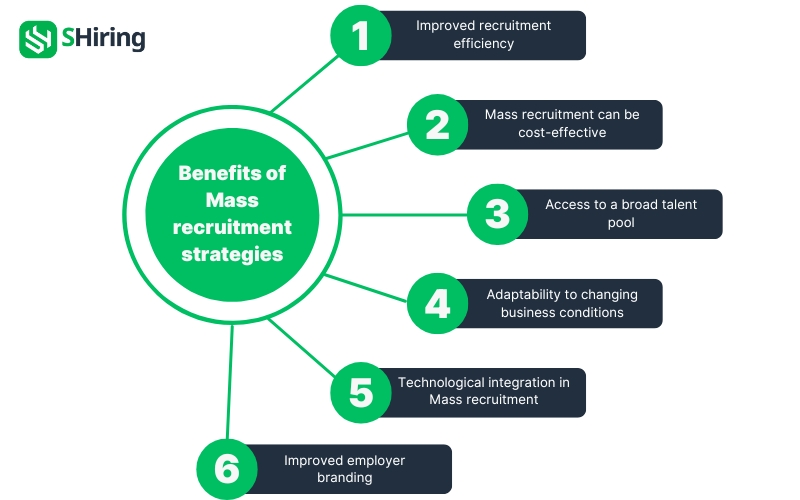
Improved recruitment efficiency
Mass recruitment streamlines hiring through systematic processes. Standardized workflows reduce administrative burden, allowing focus on candidate evaluation. Replicable hiring sprints enable quick, large-scale recruitment. Automation and AI tools boost efficiency in sourcing, screening, and shortlisting candidates.
Mass recruitment can be cost-effective when executed strategically
Mass recruitment is more cost-effective than traditional individual recruitment. It leverages economies of scale, distributing costs over multiple hires. Bulk purchasing of resources and streamlined, repetitive processes further reduce expenses. This approach is ideal for businesses aiming to optimize recruitment budgets.
Access to a broad talent pool
The extensive reach of online and offline channels allows companies to access a wider and more diverse talent pool for mass recruitment compared to traditional methods. Digital platforms and partnerships with recruitment agencies enhance access to candidate data across geographies. This broader search simplifies finding best-fit hires and tapping into unconventional talent pools with diverse skill sets.
Adaptability to changing business conditions
Flexible hiring systems allow quick adaptation to business needs. Rapid growth or high turnover industries benefit from Mass recruitment capabilities. This scalability enables leadership to align recruitment with organizational strategy, quickly adjusting hiring efforts as priorities change.
Technological integration in mass recruitment
Technology is crucial for efficient mass recruitment. AI software screens applicants quickly and accurately. Chatbots handle basic queries, freeing recruiters for important tasks. Analytics provide real-time insights, while automation speeds up administrative work. Human oversight remains essential, with recruiters evaluating results. This human-tech collaboration optimizes high-volume hiring.
Improved employer branding
Efficient mass hiring enhances employer reputation. Fair, consistent, and quick processes improve brand image, with candidates sharing positive experiences widely. This attracts top talent for future recruitment drives, especially among digital-savvy candidates.
As global competition intensifies, mass recruitment becomes crucial for scalable talent acquisition. Companies mastering high-volume hiring gain strategic advantage. Future trends will focus on cost-effectiveness, process optimization, and technology utilization.
Read more: What is Employer Branding? 6 effective implementation strategies in 2024
Challenges recruiters face in mass recruitment
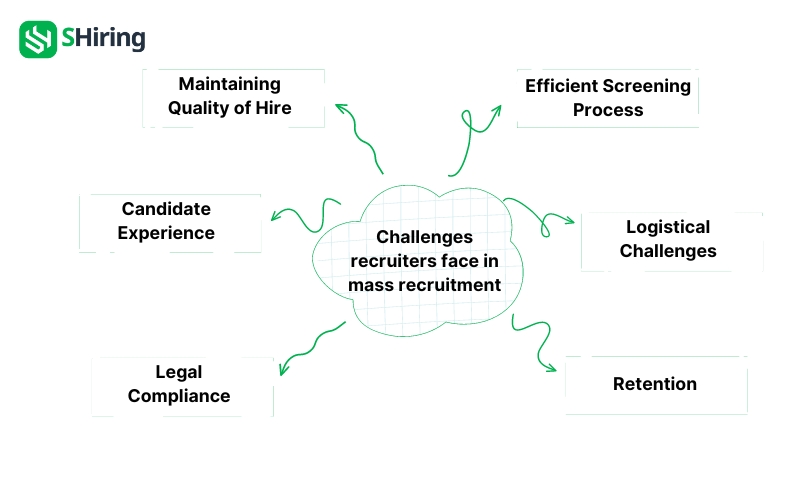
Maintaining quality of hire
Mass hiring challenges include quickly reviewing numerous applications without missing qualified candidates. Robust screening mechanisms, like pre-assessments, help streamline selection efficiently.
Example: A retailer facing thousands of seasonal job applications can use tech-driven solutions to filter candidates based on preset criteria, making the process more manageable.
Efficient screening process
Mass hiring requires maintaining a positive experience for numerous candidates simultaneously. Key factors include clear communication, respect for time, and smooth processes. Personalized feedback enhances candidate experience regardless of outcome.
Example: Companies can use automated communication to provide timely updates during mass recruitment, preventing candidate frustration and protecting their employer brand.
Candidate Experience
Mass hiring requires maintaining quality candidate experiences at scale. Key elements include clear communication, respect for time, and efficient processes. Personalized feedback enhances experiences regardless of outcome.
Example: Companies can use automated communication for timely updates during mass recruitment, preventing frustration and protecting their employer brand.
Logistical Challenges
Mass hiring demands coordinating multiple processes for numerous candidates simultaneously. It requires strong organizational skills, efficient resource use, and often technology to streamline operations. Comprehensive logistical planning and project management tools are crucial for smooth execution.
Example: A startup needing to hire 50 employees in a month can use technology for scheduling, tracking, testing, shortlisting, and onboarding to optimize resources and reduce administrative burden.
Legal Compliance
Mass hiring across regions or countries requires compliance with diverse employment laws. This complex process demands understanding of various legal requirements. Engaging legal experts or compliance firms helps navigate international labor laws and reduce legal risks.
Example: A multinational company hiring in multiple countries must comply with local laws in each location to avoid penalties, lawsuits, and reputational damage.
Retention
Post-mass hiring, retention becomes crucial. Key strategies include creating a supportive environment, offering growth opportunities, and ensuring employee engagement. Mentorship programs, competitive compensation, and a culture of continuous learning can boost satisfaction and reduce turnover.
Example: A company hiring many sales reps for a new product launch can improve retention by soliciting feedback, addressing concerns, and providing ongoing training and support.
Comprehensive 10-step approach to effective mass recruitment
Mass recruitment requires a strategic, organized, and efficient approach to attract and onboard a large number of qualified candidates. Here’s a detailed 8-step approach to achieving effective mass recruitment:
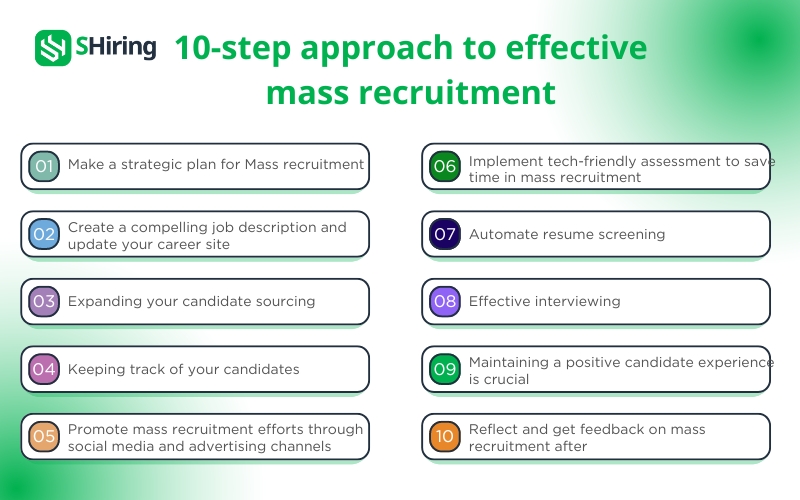
Make a strategic plan for Mass recruitment
A plan could save recruiters hours of manual and monotonous work. As a result, prior to mass hiring, it is critical to create a sequential plan that aligns with the tasks of the recruitment funnel.
Recruiters can break down the tasks of mass recruitment workflow using the recruitment funnel below, allowing them to run a smooth hiring process.
When creating your mass hiring plan, divide it into sub-tasks related to your recruitment funnel. To summarize, most recruitment funnels include seven key components:
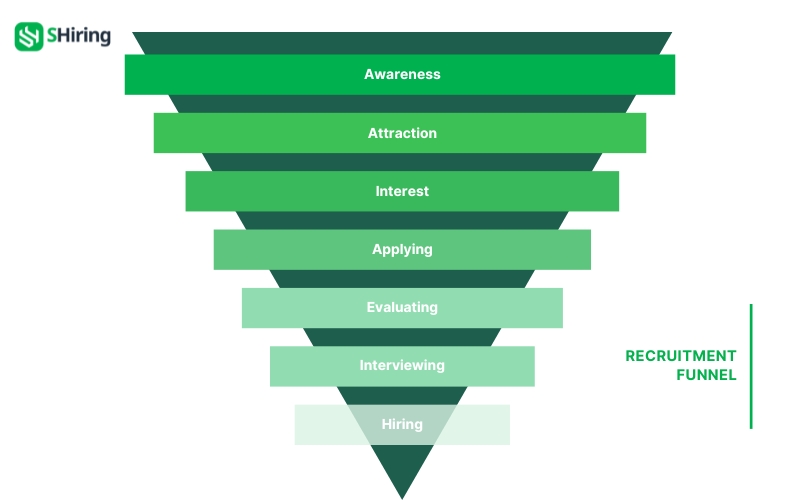
Create a compelling job description and update your career site
To streamline mass recruitment, ensure thorough planning, accurate job descriptions, key responsibilities, and the top three essential skills to avoid confusion. An effective evaluation process is crucial; thus, schedule a meeting with employees to strategize on addressing this challenge.
Requirements should be clearly structured, proofread for clarity, and easy to understand to avoid applicant confusion. Avoid unrealistic expectations and overly strict criteria.
To convey company culture and atmosphere, feature employee interviews to illustrate company values. This helps applicants grasp the work environment. Train your hiring team and establish standardized video interview guidelines to align candidate expectations with company needs accurately.
When it comes to bulk hiring, career websites are an invaluable resource for large corporations. As a result, you must update your career page and include mission, vision, or corporate DNA. It will give candidates a clear sense of your long-term goals and the company’s higher value.
According to a LinkedIn survey, 71% of applicants research the firm before applying. As a result, keep the website up to date with the most recent photos and videos from a company-organized trip, event, or gathering.
Expanding your candidate sourcing
Mass interviews are crucial for recruiting large numbers of employees, making it essential to expand the candidate pool effectively. Here are a few strategies that businesses can implement:
- Employer Branding: Building a positive employer brand attracts candidates and shortens recruitment time.
- Multi-Channel Recruitment: Utilizing various recruitment channels optimizes the candidate pool.
- Job Portals: Sites like LinkedIn, TopCV, and Vietnam Works. Choose based on target candidate profiles and success rates.
- Social Media: Post job announcements on company profiles and join recruitment groups, with a focus on platforms like Facebook.
- Employee Referrals: Encourage existing employees to refer qualified candidates.
- Job Fairs: Participate in job fairs to gather numerous applications.
- Partnerships with Educational Institutions: Collaborate with universities, colleges, and vocational schools to access recent graduates.
- Applicant Tracking System (ATS): Use an ATS to automate processes, avoid candidate duplication, and organize data centrally.
Read more: SHiring – Efficient recruitment solution integrating AI and ATS
Keeping track of your candidates
In the past, talent acquisition desks were cluttered with stacks of manila folders containing resumes, credentials, and paperwork. Despite the aid of Excel spreadsheets, managing these was still a challenge.
Today, 75% of hiring professionals rely on Applicant Tracking Systems (ATS). These systems streamline bulk hiring by automating job applications, storing and parsing resumes, managing candidate data, automating communication, and providing real-time recruitment funnel updates at the click of a button.
Promote your mass recruitment efforts through social media and advertising channels
To attract top candidates, utilize social media to showcase your company’s work environment, products, culture, vision, and mission. Once your job requirements are defined and social media profiles polished, post job ads on your website’s careers page and across social platforms.
Each social media platform attracts different candidates, so leverage all company pages effectively. Consider running targeted ad campaigns to widen the applicant pool.
Harness personal networks of HR managers and employees for referrals, as experienced individuals often know others in their field. Encourage employee referrals through incentives to tap into trusted talent sources.
Implement tech-friendly assessment to save time in mass recruitment
This step is critical as it helps identify the right candidates and filters out those who may not be suitable for specific positions. According to Toggl’s survey, 64% of skilled recruiters emphasize the importance of increasing skills assessment.
This data-driven approach ensures efficient decision-making and minimizes time spent on mass recruitment. Consequently, it reduces the stress of reviewing applications and screening candidates, allowing hiring managers to prioritize other important tasks.
Automate resume screening
Recruiters should use resume parsing software to efficiently analyze data and locate relevant applications. These tools use advanced search techniques to scan resumes based on hiring managers’ specifications. They can also screen out candidates who do not meet the position’s specific requirements.
Read more: What is Resume Parsing? A Comprehensive Guide
Effective interviewing
To streamline the complex and time-consuming process of interviewing large numbers of applicants during mass recruitment, recruiters employ several approaches:
- Fast-track interviews: These are quick assessments designed to elicit immediate responses from candidates. Unlike traditional interviews lasting 30-45 minutes, fast-track interviews focus on initial impressions. However, there’s a risk of bias, so HR managers must ensure standardized processes and evaluate candidates based on targeted questions.
- One-on-one interviews: Conducted in person, these interviews allow for direct interaction between the interviewer and candidate. This format assesses knowledge, communication skills, and allows candidates to inquire about company culture and responsibilities.
- Group interviews: These sessions assess candidates’ communication and persuasion skills in a collaborative setting. Structured discussions ensure all participants have opportunities to contribute.
Maintaining a positive candidate experience is crucial
While mass hiring, it is critical to ensure a positive candidate experience, even for those who were not chosen, as this is critical for the company’s reputation. According to a PWC survey, 49% of job seekers rejected a job offer due to poor recruiting experience during mass recruitment.
Read more: 7 Aspects of ATS implementation: Improve candidate experience
Reflect and get feedback on mass recruitment after
With the conclusion of the large-scale hiring initiative, it’s crucial to evaluate and gain insights from any missteps. This will enable the recruitment team to navigate around similar challenges and streamline processes in subsequent hiring rounds.
Conduct an analysis of applicant diversity across different recruitment platforms, identifying which channels yielded the highest number of promising candidates. Additionally, pinpoint any steps in the process that, if removed, could save time and reduce unnecessary complications.
Through this data examination, recruiters will identify which sources provided the highest conversion rates of qualified candidates, informing future recruitment strategies. Develop a comprehensive report analyzing various sourcing channels to determine the most effective ones for attracting top talent. This will allow recruiters to focus their efforts on these high-performing channels for upcoming hiring needs and events.
How SHiring helps companies with mass recruitment
SHiring assists companies with mass recruitment through a comprehensive suite of functionalities:
- CV Parsing: Extracts information from candidate CVs including experience, education, skills, and various languages.
- Centralized CV management: Stores CVs from multiple sources into a single database, ensuring accurate and detailed candidate information management.
- CV pool-based access control: Secures recruitment data by managing potential candidates according to specific job positions.
- Job posting and careersite display: Establishes a dedicated recruitment website for the company, attracting candidates and optimizing SEO.
- Recruitment campaign and open positions management: Monitors recruitment activities to streamline processes and optimize efficiency.
- Recruitment process management: Constructs tailored recruitment workflows based on organizational needs, evaluating recruitment effectiveness.
- Reporting and recruitment analysis: Digitizes recruitment effectiveness, providing comprehensive insights and detailed analytics.
- Workspace user setup and permissions: Ensures data security through role-based permissions (e.g., Director, Team Lead, Recruitment Specialist), minimizing errors, confusion, and data loss while saving processing time.
- Flexible third-party API integration: Integrates seamlessly with other applications for convenient and efficient recruitment management.
These features collectively enable SHiring to support companies effectively in handling large-scale recruitment needs.
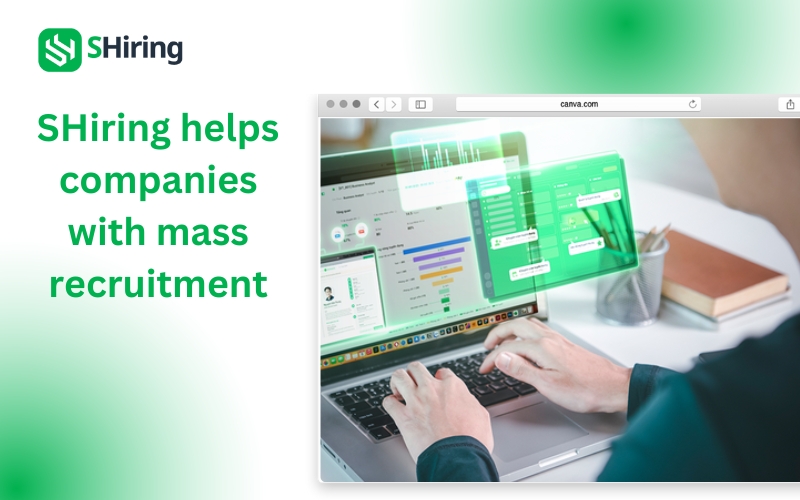
Conclusion
Mass recruitment offers a strategic approach to acquiring talent for organizations experiencing rapid growth, seasonal spikes, or large-scale projects. By implementing a well-structured plan, companies can leverage mass recruitment to efficiently identify, attract, and onboard a large number of qualified candidates.
